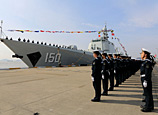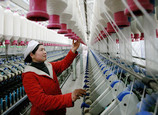
While the international circles exclaim the advent of a "war of currencies", questioning voices about China's "seriously excessive monetary issuance" are also constantly rising.
In essence, money supply is the liability of the monetary authority and its financial institutions to the public and, therefore, changes in money supply largely reflect the changes in money demand.
The commonly used indicator in measuring financial deepening level is the M2-to-GDP ratio, a proportion that reflects an economy's financial deepening level.
Generally speaking, a greater ratio means a higher degree of monetization of the economy. The latest data released by the People's Bank of China show that the balance of China's broad money (M2) was 97.42 trillion yuan as of the end of 2012, approaching the mark of 100 trillion yuan. The M2-to-GDP ratio reached up to 188 percent, a record high, while that of the United States was 63 percent over the same period, only one third of China's.
Moreover, although the trends of M2-to-GDP ratio of various countries are considerable different, none of them has monetization rate trend as steep as China's.
However, the differences among the M2-to-GDP ratios of different countries and the changes in the M2/GDP ratio of a certain country are a very complex issue to explain.
Because different countries have different monetary statistics calibers, it is impossible to carry out horizontal comparison. Developed countries have higher degrees of financial deepening level and very active financial innovations, so their statistics of money supply do not include some of the financial instruments; while the non-financial sector of some countries which have highly developed financial markets great amount of financing from other markets besides the banking system.
The monetization process of China has different structural and institutional basis from that of other countries. The core of such basis is the distribution of monetization of government-led elements, the "passive creation" under the context of international circulation of capital, and low-efficiency financial resources allocation.
First of all, the money stock is subject to the monetization level of the Chinese economy.
With the deepening of reform and opening up and the improvement in the market-orientation level, the level of China's money supply is rising, which is reflected in a higher average growth rate of money supply than that of economic performance, resulting in a constantly climbing M2-to-GDP ratio.
The process of China's market economy has its special background and is progressively reformed, in which process the government acts through policy promotion or even active participation to constantly put into the market and monetize the resources and elements such as natural resources, labor, capital, technologies, and management.
The endogenic nature of China's money supply brings about large amount of base money input, which in turn pulls money supply stronger after amplified by money multiplier.
Secondly, China also has a different mechanism of money creation from that of developed countries, namely the external supply mechanism – RMB equivalent is reserved for official foreign exchanges. This provides another critical perspective to study China's "high monetary issuance mystery".
Since joining the WTO, China's high growth of exports and accumulation of foreign exchange reserves have seriously changed the mechanism of money creation and supply structure. With the continued growth of foreign exchange reserves as well as the "sterilized intervention" policy implemented by the central bank, China's reserved RMB equivalent for foreign exchanges soared from 2.2 trillion yuan in late 2002 to 25.5 trillion yuan in 2011, up 11.5 times. The growth of such reserves also accounts for a larger and larger portion in the growth of base money of the central bank. Therefore, China's money creation is "passive creation".
Finally, the high degree of investment dependence is also an important reason promoting the passive excessive monetary issuance.
The excessive preference of financial resources toward state-owned economy and the loose constraint of budget of the state-owned sector lead to declining efficiency of financial resources.
As a result, the maintenance of high economic growth rate must rely on higher credit and money input, forming a circle of "economic growth – demand for investment – demand for money – increase in money supply", which is naturally reflected in a constantly rising M2-to-GDP ratio.
Therefore, what is behind the logic of "Chinese style excessive monetary issuance" is actually the manifestation of the combined effects of insufficient independence of central bank policies, economic structural imbalances, and laggard financial system development.
Read the Chinese version at: 如何看待中国式货币超发, Source: Economic Information Daily, Author: Zhang Monan
















 Most feared Spring Festival questions
Most feared Spring Festival questions


![]()
